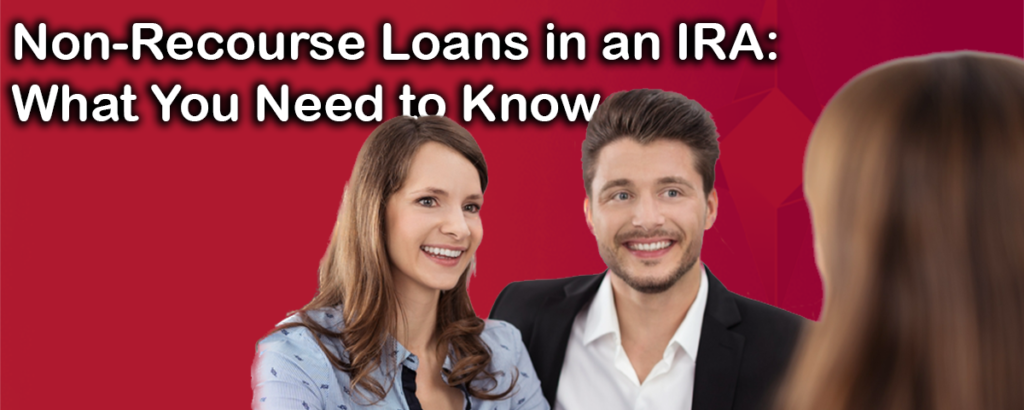
If you are looking for a way to invest in assets with your self-directed IRA, you may have come across the term “non-recourse loan.”
This blog post will explain a non-recourse loan and how it differs from a recourse loan. We’ll also discuss the pros and cons of using a non-recourse loan in your IRA.
What is a non-recourse loan?
A non-recourse loan is a loan that is secured by collateral. If you default on the loan, the lender can seize the collateral, but they cannot go after your other assets. This is often used by investors buying a property with their self-directed IRA.
What is a recourse loan?
A recourse loan is the same as a non-recourse loan, except if you default on the loan, the lender can come after your other assets to recoup their losses. For this reason, a recourse loan is the most common type of loan that lenders offer as it limits the lender’s risk. Sadly, with a self-directed IRA, lenders don’t have the option of offering a recourse loan because of how an IRA works.
How a Non-recourse Loan Works Inside of an IRA
An IRA or 401k is considered an entity. Which means they are a “person” under the law and can enter into contracts. So, when you use your IRA to buy a property with a loan, the lender must treat your IRA as a person. Because of this, they can only offer a non-recourse loan.
The most common use of a non-recourse loan is to purchase real estate.
Steps to Getting a Non-Recourse Loan
Find a Lender: You will need to find a lender that offers non-recourse loans. This can be difficult as most lenders only offer recourse loans because they like the extra risk of non-recourse loans.

One thing to note is that with non-recourse lenders, interest rates and down payments are generally higher. Down payments are typically 30% or more for non-recourse loans. Regular loans typically require 20%.
Work with a Qualified Intermediary: This is generally an IRA administrator/custodian. A qualified intermediary will hold the loan proceeds in escrow until everything is ready to close.
Once you have found a lender and qualified intermediary, you’re ready to move forward with the loan. The process is fairly simple and straightforward.
Apply for the Loan: The next step is to apply for the loan. When applying, you will need to provide collateral for the loan. This is typically the asset you are investing in.
Sign the Loan Agreement: Once approved for the loan, you will need to sign a loan agreement. This agreement will outline the loan’s terms, such as the interest rate, repayment schedule, and collateral.
Now you can use your downpayment and loan to purchase the property or investment you are interested in. A side note-make sure you make your loan payments on time.
Contact us at Accuplan if you need help in securing a non-recourse lender. We have a few recommended lenders that can help you out.
Benefits of Using a Non-Recourse Loan in Your Self-Directed IRA
- You can use leverage to increase your returns – You can control a much larger asset by only putting down a portion of the purchase price. This can lead to higher returns as you effectively leverage your IRA assets. For most IRA accounts, you simply do not have enough capital to purchase high-cost properties and investments, and this is where the non-recourse loan can help you invest in things you otherwise couldn’t.
- You can keep more cash in your account – By using a non-recourse loan, you can keep more cash in your account. This can be a great option as it gives you more liquidity in your retirement account in an emergency.
- You don’t have to worry about the loan being called – With a recourse loan, the lender can “call” the loan at any time. This means they can demand that the entire loan be paid back immediately. With a non-recourse loan, this is not an issue as the only thing at risk is the collateral (the property).
Negatives of Using a Non-Recourse Loan in your IRA
- You will have to put down a larger down payment – As we mentioned, you will need to put down at least 35% of the purchase price. This is a much higher down payment than most loans require.
- The interest rates are usually higher – Non-recourse loans typically come with higher rates than recourse loans. This is because they are considered to be riskier for the lender.
- You may have to pay origination fees – Some lenders will charge origination fees on non-recourse loans. These fees can add up, so factor them into your calculations.
As you can see, there are both pros and cons to using a self-directed IRA non-recourse loan. You will need to weigh the pros and cons to decide if this is the right strategy.
Things to Remember
The property will be held in your IRA, and any income or gains the property generates will need to go back into the retirement account. The upside is all the gains are tax-deferred or tax-free, depending on your IRA type.
Is a non-recourse loan right for your IRA? Weigh the pros and cons to decide if this investment strategy is right for you. Talk to a qualified financial advisor if you have any questions.
At Accuplan

We specialize in helping our clients with self-directed IRAs. We would love to give you professional help with investing in your IRA.
